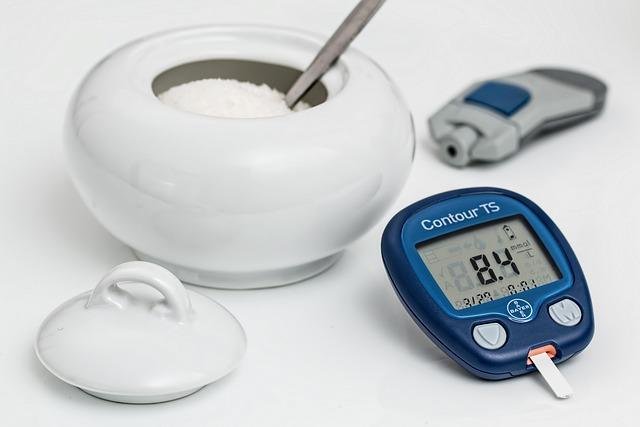In the intricate dance of our body’s metabolism, blood sugar plays a lead role—fueling our energy, mood, and overall well-being. Yet, when blood sugar swings like a pendulum, it can leave us feeling drained, irritable, or even pose long-term health risks. The good news? Nature offers a vibrant palette of foods that gently steady these fluctuations, helping to maintain balance and harmony within. In this article, we explore the best foods to stabilize blood sugar—delicious, nutritious choices that support steady energy and promote lasting wellness. Whether you’re managing diabetes or simply seeking a more balanced diet, these foods could become your steadfast allies on the path to better health.
Table of Contents
- Understanding Blood Sugar and Its Impact on Health
- Powerful Nutrients That Promote Stable Blood Glucose Levels
- The Role of Fiber in Preventing Blood Sugar Spikes
- Incorporating Low Glycemic Index Foods into Your Daily Diet
- Balancing Proteins and Fats for Optimal Blood Sugar Control
- Smart Snacking: Healthy Options to Keep Blood Sugar Steady
- Q&A
- Insights and Conclusions

Understanding Blood Sugar and Its Impact on Health
Blood sugar, or glucose, serves as the primary energy source for our body’s cells, but maintaining it within a healthy range is crucial for overall well-being. When blood sugar spikes or plummets unpredictably, it can lead to fatigue, mood swings, and long-term health challenges such as diabetes or cardiovascular issues. The delicate balance is influenced by the foods we consume, as some carbohydrates break down quickly, causing rapid glucose surges, while others release energy steadily. Understanding this dynamic empowers individuals to choose ingredients that support consistent energy levels and metabolic health.
Incorporating foods rich in fiber, healthy fats, and lean proteins can significantly aid in stabilizing blood sugar. Consider integrating these nutrient powerhouses that work synergistically to slow digestion and promote gradual glucose absorption:
- Whole grains: oats, quinoa, barley
- Legumes: lentils, chickpeas, black beans
- Nuts and seeds: almonds, chia seeds, flaxseeds
- Non-starchy vegetables: spinach, broccoli, zucchini
- Lean proteins: chicken breast, tofu, fish
| Food Group | Impact on Blood Sugar | Key Benefit |
|---|---|---|
| Whole Grains | Slow glucose release | Improved satiety |
| Legumes | Low glycemic index | Steady energy |
| Nuts & Seeds | Rich in healthy fats | Reduced glucose spikes |
| Non-Starchy Veggies | Minimal sugar content | Supports blood sugar stability |
| Lean Proteins | No direct glucose effect | Enhances fullness |
Powerful Nutrients That Promote Stable Blood Glucose Levels
Maintaining balanced blood sugar is largely influenced by the intake of certain key nutrients that work synergistically to regulate glucose absorption and insulin sensitivity. Fiber, for instance, slows down the digestion of carbohydrates, preventing rapid spikes in blood sugar levels. Foods rich in soluble fiber, such as oats, legumes, and flaxseeds, create a gel-like substance in the gut that moderates sugar release into the bloodstream. Similarly, magnesium plays a crucial role in improving insulin action and is abundant in dark leafy greens, nuts, and seeds, making these foods essential staples for anyone looking to keep their glucose levels steady.
In addition to fiber and magnesium, antioxidants and healthy fats provide vital support by reducing inflammation and enhancing metabolic function. Nutrients like polyphenols found in berries, green tea, and dark chocolate combat oxidative stress, which can impair insulin regulation. Meanwhile, omega-3 fatty acids—prevalent in fatty fish and chia seeds—help improve cell membrane fluidity, enabling better insulin signaling. Incorporating a balanced mix of these nutrients not only stabilizes blood sugar but also contributes to overall metabolic wellness.
| Nutrient | Primary Benefits | Best Food Sources |
|---|---|---|
| Fiber | Slows carb absorption | Oats, legumes, flaxseeds |
| Magnesium | Enhances insulin sensitivity | Spinach, almonds, pumpkin seeds |
| Polyphenols | Reduces oxidative stress | Berries, green tea, dark chocolate |
| Omega-3 Fatty Acids | Improves insulin signaling | Salmon, chia seeds, walnuts |
The Role of Fiber in Preventing Blood Sugar Spikes
Dietary fiber acts as nature’s brake on the digestion process, slowing the absorption of sugar into the bloodstream. When fiber-rich foods are consumed, they form a gel-like substance in the digestive tract, which tempers the rate at which glucose enters the blood. This means fewer sharp spikes and a smoother, more controlled blood sugar response throughout the day. Incorporating fiber doesn’t just moderate sugar spikes—it also supports gut health and keeps you feeling fuller for longer, reducing the likelihood of overeating or snacking on high-sugar foods.
To harness the benefits of fiber effectively, consider focusing on these powerhouse options:
- Legumes: lentils, chickpeas, black beans
- Whole grains: oats, quinoa, barley
- Vegetables: broccoli, Brussels sprouts, carrots
- Fruits: apples, pears, berries
- Nuts and seeds: chia seeds, flaxseeds, almonds
| Fiber Type | Effect on Blood Sugar |
|---|---|
| Soluble Fiber | Forms gel, slows glucose absorption |
| Insoluble Fiber | Adds bulk, promotes satiety |
Incorporating Low Glycemic Index Foods into Your Daily Diet
Choosing foods with a low glycemic index (GI) can significantly help maintain consistent energy levels throughout the day. These foods digest slowly, preventing rapid spikes in blood sugar and keeping you feeling satiated longer. Incorporate items like steel-cut oats, quinoa, and lentils into your meals to harness their steady-release energy benefits. Simple swaps such as replacing white rice with barley or whole wheat pasta instead of the refined versions can make a meaningful difference in blood sugar control.
Besides selecting low GI staples, combining them with fiber-rich vegetables and healthy fats enhances their blood sugar-stabilizing effects. Here’s a quick reference for some smart combinations:
| Low GI Food | Perfect Pairing | Benefit |
|---|---|---|
| Chickpeas | Spinach + Olive oil | Boosts fiber & healthy fats |
| Sweet Potato | Avocado + Chia seeds | Balances carbs with healthy fats |
| Brown Rice | Broccoli + Almonds | Enhances nutrient absorption |
Balancing Proteins and Fats for Optimal Blood Sugar Control
Maintaining a harmonious blend of proteins and fats in your diet plays a crucial role in regulating blood sugar levels effectively. Proteins not only support muscle repair and growth but also slow down the absorption of glucose in the bloodstream, helping to prevent sudden spikes. Meanwhile, healthy fats provide a sustained energy source without triggering rapid blood sugar fluctuations. Incorporating foods such as fatty fish, nuts, seeds, and lean poultry creates a balanced nutrient profile that promotes stable energy and enhances insulin sensitivity.
To optimize blood sugar control, emphasize whole-food pairings that combine both macronutrients thoughtfully. For example, snack on Greek yogurt topped with chia seeds or enjoy an avocado and egg salad. These combinations can reduce cravings and keep you feeling full longer. Below is a simple guide to foods that effectively balance proteins and fats for this purpose:
| Protein Source | Healthy Fat Partner |
|---|---|
| Grilled Chicken | Olive Oil |
| Salmon | Avocado |
| Tofu | Walnuts |
| Eggs | Almond Butter |
| Greek Yogurt | Chia Seeds |
Smart Snacking: Healthy Options to Keep Blood Sugar Steady
Choosing snacks that help balance blood sugar involves focusing on foods rich in fiber, protein, and healthy fats. These nutrients slow down the digestion process, preventing sudden spikes or crashes in glucose levels. For instance, pairing raw almonds or walnuts with a small serving of fresh fruit can provide a satisfying and nutritious snack. Similarly, Greek yogurt topped with chia seeds or flaxseeds offers a creamy texture while delivering essential probiotics and omega-3 fatty acids.
Incorporating colorful vegetables like carrot sticks, celery, or bell pepper slices with a hummus dip is another excellent way to keep your blood sugar steady. These fiber-packed veggies not only add crunch but also provide vital vitamins and minerals. Below is a quick reference table to highlight some ideal snack combos for optimum blood sugar control:
| Snack Combo | Benefits | Ideal Time |
|---|---|---|
| Apple slices + Peanut butter | Fiber + healthy fats | Mid-morning |
| Celery + Hummus | Low GI + protein | Afternoon |
| Greek yogurt + Berries | Probiotics + antioxidants | Pre-workout |
| Hard-boiled egg + Cherry tomatoes | Protein + vitamins | Evening |
Q&A
Q&A:
Q1: Why is it important to stabilize blood sugar levels?
A1: Stabilizing blood sugar helps maintain consistent energy, prevent mood swings, and reduce the risk of chronic conditions like diabetes and heart disease. Sharp spikes and drops can leave you feeling tired, irritable, or hungry too soon.
Q2: What types of foods help keep blood sugar steady?
A2: Foods rich in fiber, protein, and healthy fats are key players. These nutrients slow digestion and sugar absorption, preventing those sharp blood sugar swings. Think whole grains, legumes, nuts, and fatty fish.
Q3: Can you name some specific foods that are great for blood sugar control?
A3: Absolutely! Some stellar options include:
- Oats: Packed with soluble fiber that slows carb absorption.
- Leafy greens: Low-calorie and nutrient-dense, they help regulate glucose metabolism.
- Chia seeds: Loaded with fiber and omega-3s, they aid in steady sugar release.
- Almonds: A crunchy source of healthy fats and protein that curb sudden sugar spikes.
- Sweet potatoes: With a low glycemic index, they provide steady energy.
- Fatty fish (like salmon): Rich in omega-3 fatty acids, they support insulin sensitivity.
Q4: Are there foods to avoid to maintain balanced blood sugar?
A4: Yes! Highly processed carbs, sugary drinks, and refined grains cause rapid blood sugar spikes. Limiting candy, white bread, pastries, and sodas can make a major difference.
Q5: How does portion size influence blood sugar stability?
A5: Portion control is essential. Even healthy carbs can overwhelm your system if eaten in large amounts. Balancing each meal with fiber, protein, and fat slows digestion and smooths out blood sugar fluctuations.
Q6: Can drinking water or herbal teas help with blood sugar management?
A6: Staying hydrated supports overall metabolic health and can aid in maintaining blood sugar levels. Herbal teas without added sugar, such as cinnamon or green tea, may offer additional benefits due to their antioxidant properties.
Q7: What’s a simple daily tip to keep blood sugar balanced through diet?
A7: Combine carbs with protein and healthy fats at every meal. For instance, pair an apple with peanut butter or have a quinoa salad with avocado and grilled chicken. This combo acts like a slow-release energy bar for your bloodstream.
Maintaining steady blood sugar is a dance between smart food choices and mindful eating. With the right foods and habits, your body enjoys smoother energy and better overall health.
Insights and Conclusions
In the delicate dance of blood sugar balance, the foods we choose act as our most trusted partners. By embracing nutrient-rich options that support stable glucose levels, we empower our bodies to move with greater ease and resilience. While there’s no one-size-fits-all solution, incorporating these best foods into your daily rhythm can help turn the tide toward steadier energy and lasting well-being. Remember, stability begins on your plate — a small shift today can create harmonious health for years to come.

